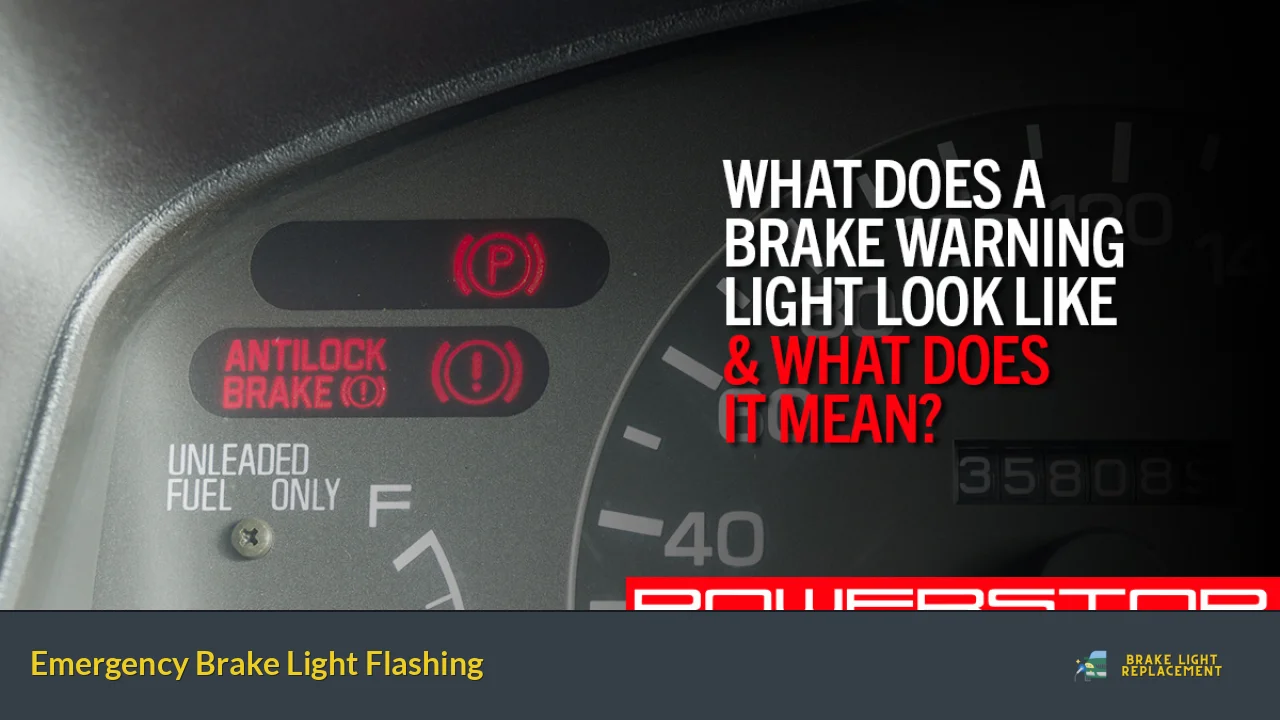Introduction:
Have you ever experienced the sudden panic of seeing your emergency brake light flashing while driving? It’s undoubtedly a cause for concern, but understanding its significance and knowing how to respond can help alleviate any immediate worries. In this article, we’ll explore the reasons behind an emergency brake light flashing and provide some guidance on what steps to take.
Reasons for Emergency Brake Light Flashing:
When your emergency brake light starts flashing, it serves as an indication that something might be amiss with your braking system. Several potential causes warrant attention, including:
-
Low Brake Fluid: A depleted brake fluid level can trigger the emergency brake light to flash. Insufficient fluid could compromise your ability to stop effectively, highlighting the importance of addressing this issue promptly.
-
Worn Brake Pads: As brake pads wear down over time, they may reach a critical point where the light begins to flash. This occurrence signals the need for immediate replacement to maintain optimum braking performance.
-
Faulty ABS System: The Anti-lock Braking System (ABS) plays a vital role in preventing wheel lock-up during hard braking. If the ABS encounters a malfunction, such as a faulty sensor or wiring issue, it can trigger the emergency brake light.
Responding to a Flashing Emergency Brake Light:
Upon noticing the flashing emergency brake light, it is crucial to take appropriate action. Here are some steps you can follow:
-
Check Brake Fluid Level: Open your vehicle’s hood and locate the brake fluid reservoir. Ensure the level is within the recommended range. If it’s low, consult your vehicle’s manual for the correct brake fluid type and add it accordingly.
-
Inspect Brake Pads: If your brake pads appear worn or damaged, it’s advisable to have them replaced by a qualified mechanic. Ignoring this warning sign could lead to reduced braking efficiency and potential safety hazards.
-
Seek Professional Assistance: If you’ve ruled out low brake fluid or worn brake pads, it’s best to consult a professional mechanic. They can diagnose the issue using specialized equipment and address any potential problems with your ABS system or other components.
Conclusion:

A flashing emergency brake light demands immediate attention as it indicates a potential issue with your vehicle’s braking system. By understanding the reasons behind this warning signal and taking appropriate steps, you can ensure your safety on the road. Remember, if you’re unsure or unable to resolve the issue yourself, it’s always wise to seek assistance from a qualified mechanic. Stay vigilant and proactive when dealing with any unexpected car warnings to maintain your vehicle’s optimal performance and your peace of mind.
Revolutionary Technology: Emergency Brake Light Flashing System Enhances Road Safety
Have you ever wondered how technology continues to revolutionize our lives? One such groundbreaking innovation that is making waves in the automotive industry is the Emergency Brake Light Flashing System. Designed to enhance road safety, this remarkable technology has the potential to save countless lives and prevent accidents on our busy streets.
So, what exactly is this Emergency Brake Light Flashing System? Simply put, it’s a smart system that detects when a vehicle ahead of you suddenly brakes hard, and instantly activates your own brake lights to warn drivers behind you. Think of it as an additional layer of communication between vehicles, ensuring that everyone on the road is aware of sudden braking situations, even if they can’t directly see the vehicle ahead.

Imagine you’re driving on a highway, and the car in front of you slams on its brakes. Without the Emergency Brake Light Flashing System, you might not realize the severity of the situation until it’s too late. But with this ingenious technology, your brake lights start flashing rapidly, catching the attention of drivers behind you and giving them valuable time to react and slow down. It’s like having an extra pair of eyes on the road, alerting other motorists to potential dangers.
This system works by utilizing sensors that monitor the rate at which the vehicle ahead decelerates. When a sudden and significant decrease in speed is detected, it triggers the flashing of your brake lights. The flashing pattern is distinctive and eye-catching, ensuring that it stands out from normal brake light signals. This immediate visual cue serves as a clear warning sign to approaching drivers, reducing the risk of rear-end collisions and providing an additional safety measure on the road.

With road safety being a top priority, the Emergency Brake Light Flashing System has gained traction among automakers and safety advocates alike. Its effectiveness in preventing accidents and increasing driver awareness cannot be overstated. By integrating this technology into vehicles, we are taking a significant step towards creating safer roads for everyone.
The Emergency Brake Light Flashing System is a revolutionary technology that holds immense potential to enhance road safety. Through its ability to alert drivers behind you of sudden braking situations, it acts as a powerful communication tool on the road. By investing in such innovative solutions, we can pave the way for a future where accidents are minimized, and journeys become safer and more enjoyable for everyone involved.
Unveiling the Future of Car Safety: Emergency Brake Lights that Communicate with Other Drivers
In today’s fast-paced world, car safety remains a top priority for drivers and manufacturers alike. With advancements in technology, the automotive industry is continuously evolving to make our roads safer. One exciting development on the horizon is the emergence of emergency brake lights that can communicate with other drivers, enhancing overall road safety.
Imagine a scenario where you’re driving down the highway, and suddenly the car in front of you slams on its brakes. In this critical moment, your instinctive reaction might be to hit the brakes as well, but what if you could receive an instant warning before you even see the brake lights? This is where the concept of emergency brake lights comes into play.
Emergency brake lights are designed to go beyond conventional brake lights by utilizing intelligent communication systems. These lights can transmit signals wirelessly to nearby vehicles, alerting them of an impending emergency stop. By doing so, they provide valuable additional reaction time for following drivers, helping to prevent rear-end collisions and potentially saving lives.
The implementation of this technology relies on interconnected vehicle networks known as V2V (vehicle-to-vehicle) communication. When a driver activates the emergency brakes, a signal is sent out to nearby vehicles equipped with compatible receivers. These receivers interpret the signal and promptly warn the drivers behind by activating visual or audible alerts.
This innovative approach to car safety offers numerous benefits. Firstly, it improves awareness among drivers, allowing them to anticipate potential hazards ahead. Secondly, it fosters a sense of shared responsibility on the road, promoting a safer and more cooperative driving environment. Additionally, emergency brake lights pave the way for future advancements in autonomous driving systems, enabling vehicles to interact and cooperate intelligently.
As we look to the future, the integration of emergency brake lights into mainstream vehicle safety systems holds great promise. However, widespread adoption will require collaborative efforts from automakers, regulatory bodies, and infrastructure development. Nonetheless, with its potential to revolutionize road safety, this technology represents a significant step toward a safer driving experience for all.
The advent of emergency brake lights that communicate with other drivers marks an exciting development in car safety. By leveraging advanced communication systems, these lights enhance situational awareness, create a cooperative driving environment, and pave the way for future advancements. As we strive to make our roads safer, embracing such innovative solutions brings us closer to a future where accidents and collisions can be significantly reduced.
Stay Alert on the Road: How Emergency Brake Light Flashing Helps Prevent Rear-End Collisions
Introduction:
Driving on the road can be both exciting and challenging. However, it’s crucial to stay alert to ensure your safety and that of others around you. One important safety feature that plays a significant role in preventing rear-end collisions is the emergency brake light flashing system. In this article, we will explore how this innovative technology works and why it is essential for every vehicle on the road.
The Purpose of Emergency Brake Light Flashing:
Have you ever wondered how other drivers know when you suddenly hit the brakes? That’s where the emergency brake light flashing comes into play. Unlike the standard brake lights that illuminate steadily, the emergency brake light system makes the brake lights flash rapidly when the driver applies the brakes forcefully or suddenly. This flashing effect immediately captures the attention of following drivers, warning them of an impending stop and reducing the risk of rear-end collisions.
Enhanced Visibility and Communication:
Imagine driving on a busy highway during rush hour. Vehicles are constantly changing lanes, and sudden stops frequently occur. In such scenarios, the emergency brake light flashing system proves invaluable. By providing an additional visual cue, it effectively communicates the urgency of your braking action to other drivers. The flashing lights grab attention more effectively than regular brake lights, ensuring that the message is conveyed promptly, even in heavy traffic or poor visibility conditions.
Quick Reaction Time:
Human reaction time is not instantaneous, especially when it comes to unexpected events on the road. The emergency brake light flashing system compensates for this delay by giving drivers behind you more time to react. The rapid flashing grabs their attention faster than conventional brake lights, prompting them to adjust their speed and maintain a safe braking distance. This split-second difference can make a significant impact, preventing potential accidents and saving lives.
Conclusion:
Staying alert on the road is paramount to ensure your safety and that of others. The emergency brake light flashing system serves as a crucial safety feature by providing enhanced visibility and communicating the urgency of your braking action to following drivers. By reducing reaction time and increasing awareness, this technology plays a vital role in preventing rear-end collisions. As responsible drivers, let’s embrace this innovative feature and contribute to making our roads safer for everyone. Stay vigilant, drive safely, and always be prepared to stop when needed.
Cutting-Edge Innovation: Emergency Brake Light Flashing Could Reduce Traffic Accidents by 30%
Article:
Imagine a world where the vehicles on our roads could communicate with each other, sharing crucial information in real-time to prevent accidents. This might sound like something out of a sci-fi movie, but thanks to cutting-edge innovation, it is becoming a reality. One groundbreaking development that has caught the attention of experts is the emergency brake light flashing system, which has the potential to reduce traffic accidents by a staggering 30%.
So, how does this innovative technology work? Picture yourself driving down a busy highway when suddenly, the car in front of you slams on its brakes. With the traditional brake lights, there’s often a slight delay before you notice the change and react accordingly. However, with the emergency brake light flashing system, the moment the driver applies the brakes forcefully, the brake lights start flashing rapidly, signaling an emergency situation.
This simple yet effective concept has the power to revolutionize road safety. By providing an instant and eye-catching warning to drivers behind, it allows them to respond quickly and decisively, potentially avoiding rear-end collisions. The flashing lights create an element of surprise, grabbing attention and triggering an immediate response from nearby motorists.
The implementation of this technology holds tremendous promise for reducing traffic accidents. Rear-end collisions are a common occurrence, accounting for a significant portion of accidents on our roads. By alerting drivers to sudden braking events ahead, the emergency brake light flashing system significantly enhances situational awareness and helps mitigate the risk of such accidents occurring.
Furthermore, studies have shown that human reaction times are greatly improved when confronted with flashing lights, compared to steady brake lights. It taps into our instinctual response to sudden changes in our environment, heightening our alertness and preparing us to take appropriate action. In essence, this innovation harnesses the power of visual cues to create a safer driving experience.
The introduction of the emergency brake light flashing system heralds a new era in automotive safety. With its ability to provide immediate and attention-grabbing alerts to drivers behind, this cutting-edge technology has the potential to reduce traffic accidents by an astounding 30%. By embracing innovation and integrating these advancements into our vehicles, we can pave the way for a future where our roads are safer, and lives are saved.
